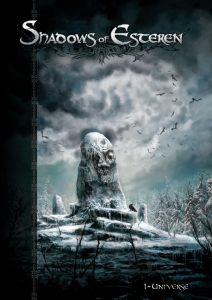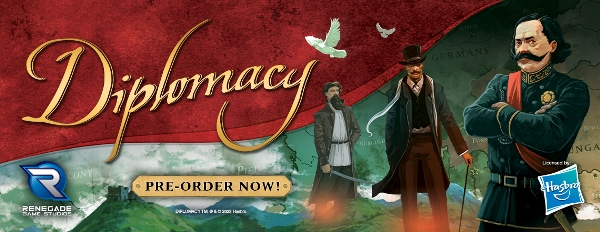Shadows of Esteren 1: Universe
Universe is the first core rulebook for the dark fantasy role-playing game Shadows of Esteren written by Nelyhann, Frédéric “Tchernopuss'” Hubleur, Aldo “Pénombre” Pappacoda, Joëlle “Iris” Deschamp, Ludovic “Elenyl” Monnier-Ragaigne, Joëlle “Iris” Deschamp, and Laurent “Nico du dème de Naxos” Duquesne and published by Agate RPG.
By Aaron T. Huss

Learn more about Shadows of Esteren 1: Universe here
Purchase Shadows of Esteren 1: Universe here
Find other Shadows of Esteren products here
Shadows of Esteren is a dark fantasy, borderline fantasy horror, RPG placed in the tri-kingdom land known as Tri-Kazel. The setting has a rich history and the book is written in a narrative fashion, describing that history and the setting as if you were hearing it from a teacher or reading it in a letter. It is a very unique read and a book filled with beautiful artwork.
Shadows of Esteren utilizes a roll-over d10 system whereas you roll a d10, add your abilities and skills, and roll equal to or higher than a predefined difficulty threshold (these don’t change throughout a character’s career). Characters utilize a tree-skill system whereas they must train within a broad ability (known as domains) before they can further their training into specific areas (known as disciplines). This is further enhanced by a character’s defining characteristics such as their personal traits. Each character is defined by their profession, social class, the path they follow “in life,” and their chosen character traits. However, during advancement the character is hindered by what improvements they can make as each defining aspect (such as domains and disciplines) are treated individually and the character may improve whichever they desire.
Shadows of Esteren introduces a new concept of magical science called Magience. It’s similar to alchemy, but should not be thought of as such as it utilizes both magic and science heavily such as you may find in some sci-fi settings. Magience is more of the high-technology of a fantasy setting. Shadows of Esteren also includes a detailed sanity system, supporting the horrific theme it totes of. Although what horrors are actually lying past the walls of sanctity is not really detailed in Book 1: Universe, I’m sure it will be heavily discussed in the Game Leader’s book, which should be book #2.
CONTENT
Tri-Kazel is an extended gazetteer of Tri-Kazel and its inhabitants. You learn all about the history of the tri-kingdom area and gain a deeper look at the major locations across the land.
Lifestyle is a deeper look at the people of Tri-Kazel including informatino on their habits and customs, crafts, food, architecture, societies, currency, and art forms. It is essentially an extension of the gazetteer with a focus on the actual inhabitants instead of the land and its history.
Factions talks all about the major organizations within Tri-Kazel including the Demorthen, the Temple, and magientists along with presenting some of the rumored organizations within the tri-kingdom area.
Game System is the actual character creation and core mechanics section. This is a lengthy chapter discussing everything a player knows to create a character and play within the game’s core mechanics including magience and sanity.
OVERALL
Book 1: Universe is basically the Player’s Guide. This contains all the core information of the system and setting and presents the players with everything they need to play a game. It does not contain the in-depth Game Leader (the Game Master), but can essentially be used for the most basic encounters and adventures. The setting is a very rich setting, although determining how the setting connects in-game is a bit tricky. I find it difficult to understand what the underlying theme of the Shadows of Esteren is, but it appears to be one of basic survival against nature, other kingdoms, and the horrors that haunt the land.
It should be noted that Shadows of Esteren is a very well-developed setting as much as it is an RPG game system. Almost 2/3 of the book is given over to the setting and is an extremely interesting read. Even if you don’t care for the game’s mechanics, the setting can be used virtually anywhere as it is not dependent on the actual Game System.
RATINGS
Publication Quality: 8 out of 10
Book 1: Universe is a beautiful book with lots of incredible artwork and no shortage of great material. I did find that Chapter 1: Tri-Kazel seemed a bit over-published as it contains a high number of illustrations, sidebars, and text boxes that sometimes break the flow of the content. Some of these appeared in the middle of the content, breaking a given section. There are also times where the layout and changing of the number of columns became confusing going from one page to the next and from the top of a page to the bottom. It’s almost as if their Kickstarter landed a lot of extra money that they felt needed to be used.
The good thing is that chapters 2, 3 & 4 do not have this same problem and I found the layout and formatting to be quite favorable and the content very easy to read. I did struggle a bit going through Chapter 1 with all the unnatural breaks in the content (due to to aforementioned illustrations and text boxes), but there were no struggle in the rest of the book.
The fluff within Book 1: Universe is done in a narrative fashion. This has the slight drawback that there is a fair amount of non-value added content due to the conversational design of the narrative. In addition, the narrative is not from a single source and instead jumps around from character to character throughout, which in itself can get a bit confusing. Although this results in some unnecessary space being consumed by the non-value added content, it doesn’t amount to very much and still results in a very interesting read. You should simply be aware that there are points in the fluff content that are conversational, breaking away from the meat of the narrative and the flow of the content.
Mechanics: 9 out of 10
Shadows of Esteren utilizes a unique game system and implements a lot of mechanics that match the setting’s theme. The design of Magience is additionally unique and presents a bit of intrigue with the potential in a character and any adventure by further exploring this magical science. The skill tree does an excellent job of representing basic and advanced training and the lack of defined classes means you can take your character in any direction desired. As with other systems, character creation is a backward-looking-forward technique where you design your character’s background but looking forward, they are not hampered by any background decisions.
Desire to Play: 9 out of 10
The setting of Shadows of Esteren is very intriguing and from a dark fantasy / fantasy horror standpoint could draw in many new fans. The core mechanics are simple enough that adventure and campaign play could be very enjoyable, allowing you to take your character in any direction possible. The follow-on books should (hopefully) better explain the adventure and campaign concepts of the game, but even after reading the content, you get the semblance of “survival of the fittest” as one of the key concepts.
Overall: 9 out of 10
Shadows of Esteren: Universe is a very well-developed book when it comes to the game’s setting and core mechanics. Albeit a bit pricey ($50 color hardcover), you really get a lot of in-depth information about the setting and of course all the mechanics needed for game play. Game Leaders will need to purchase at least one additional book for proper running of adventures and campaigns (there are no creature or NPC stats in this book), players will only ever need this book to get their games going and advance their characters through their full career. Additionally, there are a lot of beautiful illustrations and the setting is so rich that the characters can really immerse themselves in their surroundings.

